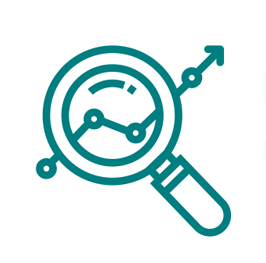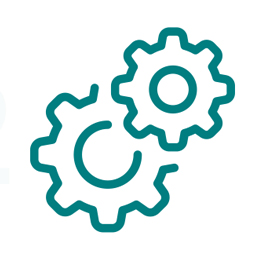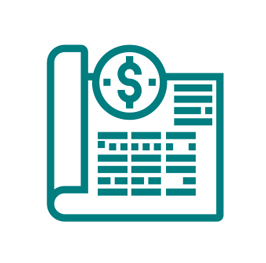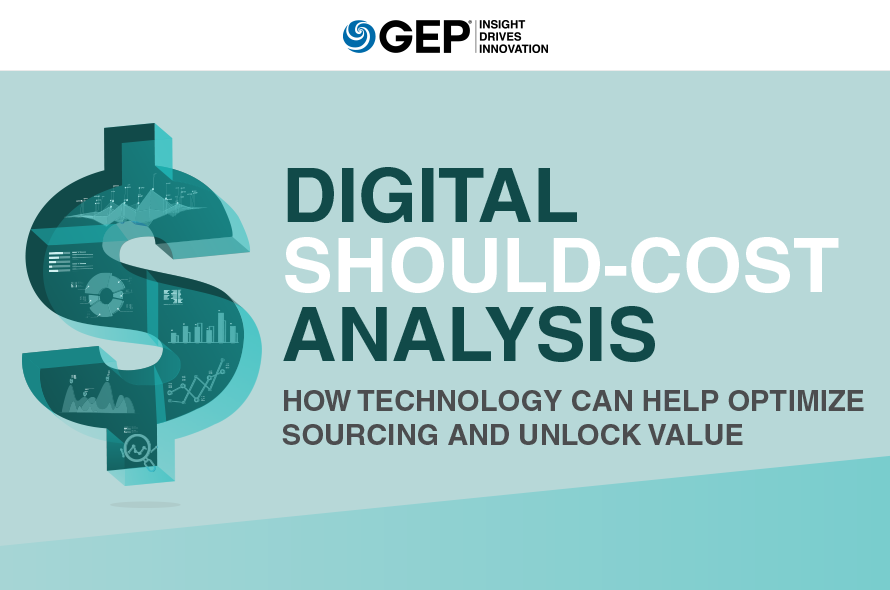Procurement has a lot more on its plate today, but its essential mission — acquiring the right products, at the right time, at the right price — has not changed. Should-cost analysis is an increasingly important tool for procurement organizations that want to maximize savings and value.
In this new white paper — Digital Should-Cost Analysis: How Technology Can Help Optimize Sourcing and Unlock Value — GEP’s experts explain how this new digital model has been made possible by new technologies and why it’s far superior to manual, DIY calculations. The paper also outlines steps for developing a custom-fit should-cost model that will serve as a strategic decision-making tool, enabling better negotiations and better supplier selection.
Why Read It:
- The real value of should-cost analysis for procurement
- The technology foundation: AI and machine learning integrated with existing systems
- Four steps for developing digital should-cost capability for your enterprise
A must-read for procurement professionals who want to jump-start cost savings and make measurable improvements in the value chain.
There’s value. And there’s price. Closing the gap between the two to determine the total cost of ownership is the challenge that every organization faces. Should-cost analysis is the methodology that breaks down the many component parts of a cost to determine the most accurate value possible. The key is deep data access from multiple sources, and a coordinated systematic approach to garnering the most insight, enabled by AI technology.
This white paper outlines why digital should-cost analysis matters, and how it works. It’s made possible by technology that didn’t exist just a few years ago, and is now fast emerging as a highly effective way to optimize the enterprise value chain. One important note: this isn’t technology that’s replacing current systems and procedures; it is, instead, augmenting them, which makes it relatively easy to implement, especially when done in stages.
WHAT IS SHOULD-COST ANALYSIS?
Should-cost analysis helps you to determine fair pricing for the goods and services your organization purchases. It identifies key cost drivers, enabling you to know the true cost of goods at any given time, take greater advantage of price variations, negotiate more effectively, and choose suppliers more strategically.
Of course, the more details you know, the more precisely you can determine what something should cost. But getting an accurate picture of the many different variables that affect pricing requires as holistic a view as possible of multiple sources of data. Not all kinds of information will be made available by all suppliers, but having the right processes, tools, expertise, and technologies in place enables you to gain greater visibility, which in turn helps keep costs in line.
In other words, the more you know, the less you spend.
THE OLD WAYS ARE THE SLOW WAYS

The problem for many companies is that they do not have a consistent methodology for performing accurate should-cost modeling. It’s often ad hoc at best, and the results can never be fully validated because the sources of data are rarely comprehensive, and are often static, inaccurate, incomplete, or outdated.
Some may, for example, use manual processes to do their analysis — spreadsheet software or even paper — which of course are time-consuming and error-prone. At the same time, a great deal of costing information is not documented or archived properly at all, is not easily accessible, and simply can’t be found.
Disparate, one-off, siloed solutions such as these can’t possibly provide the insights needed to make accurate cost assessments. A centralized, digital solution is the better way.

THE PROBLEMS WITH DO-IT-YOURSELF
SHOULD-COST MODELING
- One-off analysis is incomplete
- Limited links to procurement and supply chain processes
- Static, inaccurate and outdated data requiring manual linkages
- Narrow scope and focus limit total value chain impact
- Expertise lost or reduced when users transition
- Limited scope of deployment
DIGITAL SHOULD-COST MODELING MEANS MORE CAPABILITIES
A digital should-cost modeling solution, enabled by AI analysis of data from multiple sources, provides deep insight into the origins of specific costs. It can accommodate large volumes of data from disparate sources, integrating fully with resources throughout the enterprise.
This data underpins dynamic, automated cost reporting, yielding insights into subject matter as diverse as geography, labor rates, material rates, market fluctuations, and more.
After initial one-time setup of the digital cost modeling solution, future models only require ongoing management. Real-time evaluation of the cost models can be performed across key categories, with no requirements for manual updates on the input price data. And at the same time, the solution provides automated opportunity pipeline development through an AI-based assessment of price trends, enabling further visibility into pricing forecasts.
WHAT IS THE REAL VALUE OF SHOULD-COST ANALYSIS?
Most implementations of digital should-cost modeling can be expected to achieve 3–10% incremental savings within the first year. The reasons are multifold.
First, and perhaps most important, is that it provides a deeper understanding of supplier cost drivers by creating a fact-based negotiation platform, enabling you to focus on costs rather than price. In effect, this gives you a greater negotiation advantage with suppliers because you have a clear window into labor, equipment, overhead, and profit costs — a complete view of the entire cost structure.
This further enables you to increase cost transparency by identifying suppliers with structural cost advantages who deserve long-term relationships and investment. This ultimately can help to further drive down costs while at the same time increasing your team’s knowledge of the supplier’s products or services. You therefore get greater control of more information and the buying agenda.
And while a digital cost modeling implementation has clear advantages for your organization, it actually benefits your suppliers, too. It makes it easier to build long-term supplier relationships by showing that bottom-line price is not the only concern. (Think of it as a proactive versus a “hammer” effect when it comes to price negotiations.)
By focusing on cost rather than price, you can help suppliers identify areas where they can improve and, over time, reach a better cost position. It’s a way of more tightly partnering with suppliers to jointly reduce costs through insights into a supplier’s cost drivers and economics. By working together, it’s possible to reach a common goal and reduce waste at the same time.
WHAT ARE THE COST DRIVERS OF A SHOULD-COST ANALYSIS MODEL?
A should-cost analysis model provides comprehensive analysis and insight into several cost drivers. By examining each on its own and then together as a whole, it is possible to gain deep insights into the optimal pricing for specific goods and services. Here are six key considerations for a should-cost model:
Raw Materials
Prices are collected from suppliers based on the bill of materials as well as external benchmarking.
Base Wages for Labor
This is an estimate from the ground up of total effort to support a scope of work, which includes hourly labor rates for suppliers benchmarked against rates reported by official sources (such as the U.S. Bureau of Labor Statistics).
Overheads
Overhead calculations are defined based on the type of work, the scope of work, and the region, benchmarked against standardized burden rates for comparison.
Energy
The energy cost defined based on information provided by suppliers and benchmarked against standardized metrics available from credible sources.
Packaging, Transportation and Other Inventory Carrying Costs
Information on all other elements like packaging and transportation is typically collected from suppliers. Other inventory-carrying costs are calculated based on weighted average cost of capital (WACC) and other enterprise metrics.
Markups and Margin
Margin estimates are collected from the supplier, or are derived from external benchmarking based on type of service, industry, or product type.
KEY ELEMENTS OF DIGITAL SHOULD-COST MODELING
A should-cost analysis model is a strategic decision-making tool that enables better negotiations and informs better supplier selection. In essence, it has the capability to become a self-sustaining engine that continues to run in the background, providing critical information on demand. Its fundamental energy source: the technology that powers the decision-making through automation, process mapping, database access, and reporting. An artificial neural network using machine learning is overlaid on existing systems to enable rapid implementation.
So, at various stages of the procurement process, with minimal user input, it affords automated cost estimates based on algorithms and established guidelines to determine various costs. It examines entire value chains through production process mapping, covering specific sequences, best practices, material excess criteria, typical setup times, item complexities and more, providing standard and custom analysis for novice users as well as category subject matter experts.
It links to supplier databases and related IT systems to access shareable cost details (e.g., rate information across various suppliers and geographies), offering regular updates to ensure the most recent data is being used to produce a cost estimate.
And it furnishes reporting with complete visibility into the total product cost, including attribute, material, processing, consumable, and tooling costs. With this comprehensive reporting, it also makes guided recommendations on the steps to take to reduce costs through supplier negotiations and design-to- cost initiatives.
FITTING INTO YOUR EXISTING INFRASTRUCTURE TO CREATE A CoE
There should be no need to reinvent the systems and procedures you already have in place. A digital should-cost model should easily integrate with your existing cost modeling infrastructure, with technical and logistical support to help ensure the models are updated and accessible by individual category managers.
At its most impactful, should-cost modeling technology works seamlessly with your internal analytics teams, market intelligence, tools and frameworks, augmenting your in-house expertise and informing your subject matter experts. By integrating into your existing infrastructure, should-cost modeling can become a vital component of a Center of Excellence for cost modeling, which category managers can draw from to negotiate with suppliers and advise internal stakeholders.
The outcome: comprehensive visibility of costing throughout the enterprise, informed by every possible data source, and easily accessible (as well as comprehensible) to every stakeholder.
HOW TO DEVELOP SHOULD-COST CAPABILITY
We recommend that companies follow a four-step process to develop comprehensive should-cost capabilities:
STEP 1

Data Collection and Preparation
Start by collecting data from a range of sources, including ERP, spend analysis and invoices.
Then work with key stakeholders within your organization to map out the independent components of a should- cost capability. This helps you fully understand the primary and secondary cost drivers, as well as the impact of yields, technologies, and scale. Focus on a single category first for the purposes of a trial. This will enable you to build a skeleton should-cost model that can then be applied to other categories.
STEP 2

Value Chain Analysis and Hypotheses Development
In this step, establish a set of hypotheses by taking into consideration the value chain, which helps you to identify incremental opportunities. (For example, providing visibility of a supplier’s markup that’s concealed as an “all-in” delivered price.) From there, you can build the analytical models to validate the hypotheses.
STEP 3

Estimation and Cost Model Development
To develop a workable and accurate cost model, identify the interrelationships of different costs discovered in the value chain analysis of Step 2. Using market benchmark data, do a comparative breakdown of costs pertaining to materials, labor, margins, overheads, logistics and more. Based on this breakdown, you can create a should-cost model structure using input from subject matter experts, and scale the model as required.
STEP 4

Test and Deploy Technology
At this stage, you can put the model into practice by applying it to live projects. Identify any variances and make adjustments to the model’s assumptions and supporting logic as needed. Your technology provider should offer training and ongoing support to category managers to help ensure they can thoroughly leverage the tools and processes to their advantage.
A FINAL NOTE ABOUT PROCUREMENT TECHNOLOGY
The software used by your procurement organization should feature advanced should-cost analysis and forecasting capabilities as part of a comprehensive cost management solution for direct and indirect categories. The platform should have built-in capability to cleanse, validate, classify and report spend data from all your source systems to provide accurate, actionable information, with granular, item-level visibility across the enterprise. This will help you fully understand what you really spend on, who’s doing the spending and where, and most important, if you’re getting your money’s worth.

